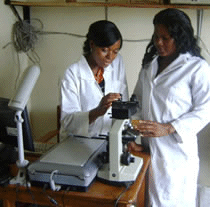
 |
|||||||||||
 |
|||||||||||
|
|||||||||||
|
Sponsored links
|
| Computational Biochemistry for beginners:- |
Review of the essentials of computational Biochemistry; importance and implications. (Page 1)
The major Biomolecule studied in computational Biochemistry are the DNA and protein. A lot of work has been done to unravel the mysteries of transfer of genetic information from parents to offspring through the DNA and the machineries through which this takes place, which also is the ultimate product of DNA metabolism (the protein). Effective discussion of protein cannot be made without making mention of DNA from which it is derived. The DNA is an organic macromolecule made up of deoxyribose sugar and phosphate backbone, with a cross linking arm of a nitrogenous base which can either be purine or pyrimidine. They are usually found in the body in a duplex intertwined state, which actually consist of two complimentary strands of DNA. The important part of DNA that decides the kind of information it carries is the Nitrogenous base arm . The pairing of the double stranded DNA follows a particular pattern. There are four major nitrogenous bases that can be found in the human DNA; Adenine, (A) Guanine, (G) Cytosine (C) and thymine (T). The two purine bases A and G complementarily pairs with the two pyrimidine bases, thymine and cytosine respectively with a double and triple bond respectively to give a double stranded DNA. Importance of gene and chromosome in protein synthesis back to top Each gene occupies a specific position in a chromosome in all organisms of the same species. For example in all human, the gene that codes for Elastase 2 neutrophil is found in chromosome number 19 and spans through position 803,291-807,246 of the DNA sequence for that chromosome. The knowledge of the gene location of any particular gene or protein is very important for research studies that involve gene extraction or transgenic and genetic engineering studies. DNA sequence and mRNA back to top DNA sequence contains the raw and unedited sequence of the nitrogenous bases present in the chromosome. Before a gene is used to manufacture any protein, the information of the gene present in the chromosome is transcribed to a messenger RNA. (mRNA) Usually when there is a SNP, the different nucleotide, will alter the codon sequence, which will also affect the type of amino acid that is encoded by the codon. The alteration in the amino acid will also cause an alteration in the final three-dimensional structure and function of the protein. Genetic Disease back to top Since faulty genes are the main cause of genetic disorders, its treatment also requires that the faulty gene is located and subjected to different genetic therapeutic techniques such as gene replacement therapies. Such work requires extensive knowledge of computational biochemistry. page 1page 2 page 3 page 4
|
||
| Has this site been of any use to you? Why not help us by informing other Nigerian Bioscientists and indeed all bioscientist about us. You can also help us to serve you better! . Thanks for visiting nigerianbioscientist.com! |
